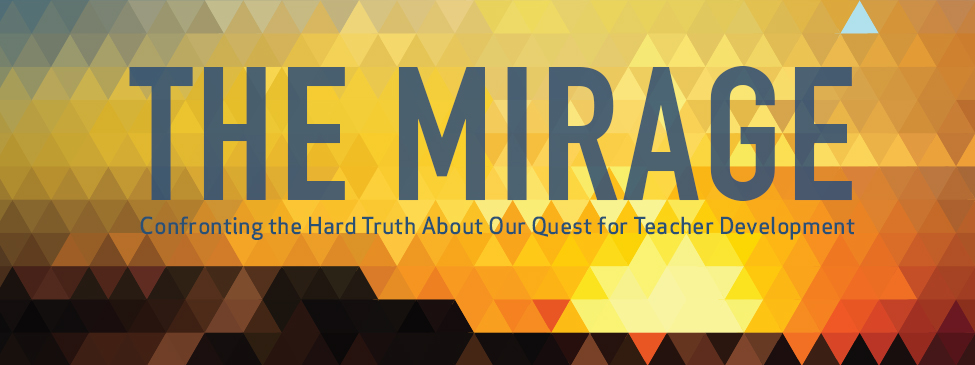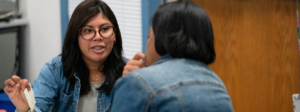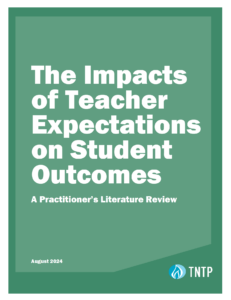Two years ago, we set out to investigate how teachers improve, hoping to uncover particular strategies or approaches that could foster widespread teacher improvement. We took an in-depth look at how three large public school districts and one charter school network support their teachers’ professional growth. Along the way, we surveyed more than 10,000 teachers and more than 500 school leaders and interviewed more than 100 district office staff members.
But we were disappointed not to find what we were looking for. Instead, we found that the enormous investment districts are making in teacher improvement isn’t helping nearly enough teachers actually improve. School systems really are trying to help their teachers, but they’re not helping nearly as much as they think.
Conventional wisdom on teacher development tells us that we already know what works when it comes to professional development for teachers—typically “job-embedded,” “ongoing” and “differentiated” kinds of development opportunities, in contrast to old-school “drive-by PD.” We have long believed that if we could just apply those kinds of opportunities more widely, we could improve the quality of classroom teaching in short order. But our findings have convinced us that this conviction is a mirage—not a hallucination, but a refraction of light that causes an object’s position to be distorted. Great teaching is real, but we are much further from achieving it at scale through professional learning than we once believed.
Here are some more details about what we learned:
School systems are making a massive and laudable investment in teacher improvement. The districts we studied spend an average of $18,000 per teacher, per year on development efforts. Based on that figure, we estimate that the largest 50 school districts in the country spend at least $8 billion on teacher development every year. And teachers devote nearly 10 percent of a typical school year to development activities.
[related]
Yet most teachers do not appear to improve substantially from year to year, even though many have not mastered critical skills. In the districts we studied, only about three out of 10 teachers substantially improved their performance over the course of several years, as measured by evaluation ratings. And many teachers’ growth plateaus even though they still have plenty of room for improvement. As many as half of teachers in their tenth year or beyond were still given observation ratings below “effective” in core instructional practices, such as developing students’ critical thinking skills.
Despite searching exhaustively, we found no evidence that any particular format or amount of professional development consistently helps teachers improve. Even when individual teachers improve substantially—and we found examples of teachers who improved measurably in 95 percent of the schools we studied—we found no common threads that distinguish them from teachers who do not. Unsettling though this is, it’s consistent with prior research: In the last decade, two federally funded experimental studies of sustained, content-focused and job-embedded professional development have found that these interventions did not result in long-lasting, significant changes in teacher practice or student outcomes.
School systems are failing to help teachers understand how they need to improve—or even that they need to improve at all. The vast majority of teachers in the districts we studied were rated at least “effective” on their overall evaluation ratings, even while student outcomes remain far below where they need to be. Perhaps not surprisingly, less than half of the teachers we surveyed agreed that they have weaknesses in their instruction.
These findings are sobering. But we want to be very clear: We do not believe the right response is to cut investments, in either time or funding, in teacher support. That would be disastrous. In fact, the charter network we studied spends substantially more than the districts we studied on teacher development, more than $30,000 per teacher, per year. But they see much more widespread improvement in teacher practice—seven out of 10 teachers show substantial improvement—and a greater sense of urgency among teachers to improve, with more than 80 percent agreeing they have weaknesses in their instruction.
[subscribe]
Rather than give up on teacher development, we think it’s time for school systems to radically upend their approach. We have all—ourselves at TNTP included—profoundly oversimplified and underestimated the challenge of helping teachers improve. Solving this problem will take much more than a few tweaks to professional development catalogs or “better implementation” of the same old strategies. First, we have to stop giving professional development a pass. For too long, we have believed that “high-quality” professional development is inherently positive, and more is always better. In reality, professional development should be viewed as a means to an end: better teaching practice and student achievement. As such, we should assign concrete, measurable goals to development initiatives and invest in those that actually produce the desired outcomes.
We should also test new approaches; for instance, school systems could try devolving funds currently spent on central personnel directly to teachers to spend on development as they see fit. Finally, we shouldn’t assume that we will be able to develop our way to consistent teaching excellence under current education models. We should also invest in other paths to our goal of great teaching in every classroom; this means testing new structures for the teaching job, piloting alternative school design models, and rethinking how we train and license teachers.
We know that many people will respond to our findings with questions: Did we look at the right interventions? The right kind of implementation? The right districts? Perhaps there really are strategies out there that are consistently leading large numbers of teachers to new heights of performance. We hope that’s true. That’s what we hoped to find when we started this research, in part because we are an organization that believes deeply in the potential of our nation’s teachers and occupies itself with training and developing teachers every day. But that’s not what we found. If there is evidence out there that differs from ours, we’re eager to hear about it and learn from it.
In the meantime, though, we believe the path forward is to forge a new conversation about how to support teachers, one that asks fundamentally different questions about what great teaching means and how to help more teachers get there. We hope you’ll be part of that conversation, starting with reading The Mirage and sharing your thoughts with us.
Still want to know more about teacher development and our findings? We’ve created a list of frequently asked questions for curious readers, too.








